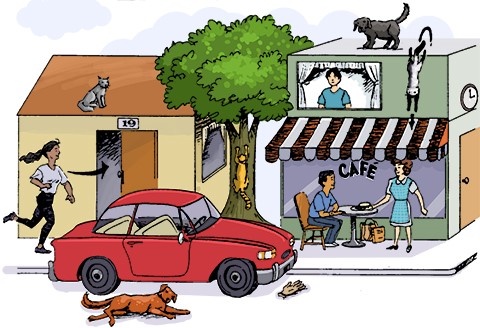1 When you imagine a college classroom, what do you see? Is there a
professor at the front of a large hall giving a lecture while students sit in rows,
listening and taking notes? Or are students sitting at tables in groups of four and
five, discussing a problem they are trying to solve while the professor moves from
group to group to answer questions? More than likely, the first arrangement came
to mind when you thought of this classroom. This situation represents the most
common classroom interaction, the one which is most familiar to all of us.
2 Researchers who study classroom interaction would describe the first
arrangement with a professor lecturing as a teacher-fronted classroom. In a
teacher-fronted classroom, the instructor's talk is most important. In these
classrooms, the teacher decides the topics that will be discussed and also decides
when a student will talk. Many students are comfortable with this kind of
interaction and classroom organization because they have experienced it
throughout their school experiences. Primary school teachers often use a teacherfronted classroom to help students with their learning. For example, a first grade
teacher may tell a story about a zebra and then ask several questions such as,
"What color is a zebra?" The students will then answer, "Black and white." Or
the teacher may ask, "What letter does the word zebra start with?" and the
students will answer, "Z." In these situations, the teacher already knows the
answer to the questions. However, he or she asks these simple questions to help
the students build their confidence and to help them learn how to participate in
class.
3 The teacher-fronted classroom may work well at the lower levels, but it
does not necessarily work well at the college level. Often, students in college
would like to ask their own questions or introduce their own topics,
especially when working on something difficult. They also may wish to have
more detailed discussions which go beyond a question / answer organization.
Finally, they may want to have discussions with fellow students in class as
well as with their instructors. In contrast, a college professor may choose to use a
teacher-fronted format simply because he or she has so much material that must
be covered in a single lecture, and there is not enough time for long discussions in
class.
4 The second scene, with students sitting in groups, is called a
student-centered classroom. In this type of classroom organization, student talk,
rather than teacher talk, is most important. Students have the opportunity to ask
questions, start new topics and follow up with longer discussions with both
classmates and teachers. Very often, in this type of classroom, students are
seated in chairs at tables rather than seated in a row. They have the opportunity
to move around as they complete their classroom assignments. This type of
organization is often very popular with teachers and students, but it does create
more responsibility for the instructor who has to participate in many different
discussions and who must do much more planning to have a successful class.
Why do primary school teachers use "teacher-fronted" interaction in their
classrooms?
a. It helps young students learn how to participate in class.
b. It is a much easier way to design a classroom.
c. It is not possible to do group work with younger students.
a
You might also like to view...
"Justin promised to lend me his textbooks for my classes next summer" is an example of a. a verb tense error
b. a subject-verb agreement error. c. a correct sentence.
Complete the statements that follow each of the paragraphs below by choosing the letter of the correct response.
(1) The promise of steady work, good pay, and kinship ties at first lured eager rural young women to the mills in nineteenth-century New England. (2) Many pairs of sisters and cousins worked in the same mill and lived in the same boarding house. (3) They helped each other adjust, and their letters home drew other kin to the mills. (4) Young women then had few opportunities for work outside their own homes, and the commercial production of yarn and cloth had reduced their workload in New England farm households. (5) Averaging sixteen and one-half years of age when they entered the mills, the girls usually stayed only about five years—few intended to stay longer. (6) Their earnings brought them independence and the freedom of deciding whether to spend or save their earnings. The subject of sentence 4 is a. opportunities. b. New England c. young women. d. workloads on New England farms.
Beschreiben Sie in sechs Sätzen, was Sie im Bild sehen. Benutzen Sie die richtigen Verben und eine Präposition in jedem Satz

What will be an ideal response?
A paragraph usually discusses __________
a. one main idea b. several main ideas